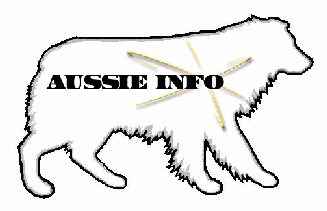
When finished reading any article on this site, please use your "back" button on your browser to return to the main topic pages.
The Australian Shepherd: A Good Herding Dog
by Lee Larochelle, Larochelle Bros. Cheviots and Australian Shepherds, Rochester NH, reprinted from Vol. XXXXVI, No.l, January-February 1978, of the Mid States Wool Growers News.)
In the Australian Shepherd, which is considered
to be a rare breed,
I have found true working ability.
It is commonly accepted that the Australian Shepherd originated in
the Basque region on the border of France and Spain. There on the
slopes of the Pyrenees mountains they moved sheep for the Basque
shepherds from summer pastures to fall to their winter and spring
and back for generations. Here they acquired the traits which set
them apart - intelligence, versatility, loyalty, protectiveness to
the flock and their owners' positions [possessions?], and the
ability to work all day just for a smile, a kind word, and the
pleasure of their master.
In Australia the Aussie was used to improve the English herding
dogs. Thus it is obvious that some outcrossing has occurred but to
improve the dog's herding ability has always been the concern. The
Australian Shepherd now for many generations has been pure bred to
protect the qualities which make it a truly great working dog.
The acquisition of a three-month-old pup from Berkshire Aussie
Kennels (RFD 1, Epping, NH) was the true test. Having never owned a
herding dog I had no idea of how to train one, but by the time the
pup was 10 months old I had a useful farm hand in my dog. I had not
realized just how much help she really was until one day for some
reason or other she could not join me in doing the chores. I had
forgotten all the running I had been doing before I got my Aussie.
Some of the jobs she does for me are heeling or pushing the sheep
out of the barn before feed-up time, checking the boundaries and
taking home any stragglers after the sheep have been gathered into
the barn which requires the heading instinct, bringing the sheep to
and from the pasture, cutting one or a group of sheep apart from the
flock for inspection or separation into other pastures. She helps
unload and load sheep at fairs, catch sheep in large pens and
exercise show sheep. She has also helped load a group of 50 market
lambs purchased at a 4-H market lamb sale. Along with herding sheep,
she has worked angus cattle, horses, ducks, poultry and swine.
Although the Aussie style of working is fairly fast, they can be
slowed down with proper training. It is known that many border
collies are fast working until trained to work slowly. In fact, the
Aussie is so versatile it will work to suit you.
I own about 75 head of Cheviot sheep. My Aussie can and will herd
these sheep without causing them to scatter. The Aussie has some eye
(a deep hypnotizing concentration on the sheep) to little eye.
Trials men will tell you that a strong-eyed dog may be most
difficult to train because it becomes so entranced it can only see
and hear the sheep and can't acknowledge the handler.
The Aussie is a quiet worker if taught to do so from puppyhood. I
can count on one hand the times my three-year-old bitch has barked
and she has never done so at livestock.
As Dwight Holaway, National Blue Print Coordinator for the American
Sheep Producers Council, said at a supper for N.H. Sheep
breeders, "One thing the sheep industry needs are more good sheep
dogs." Believe me when I say that the Aussie is a good herding dog!